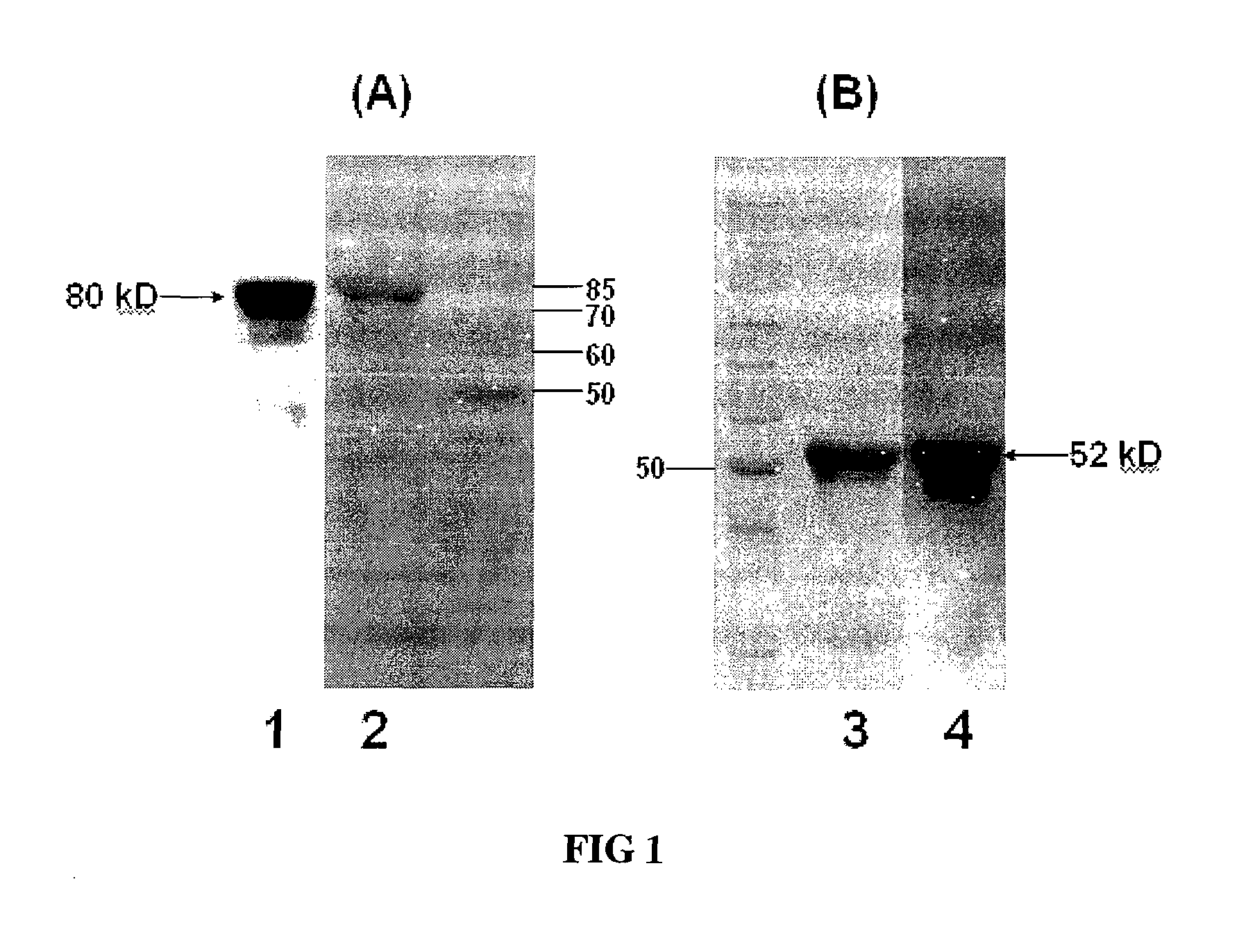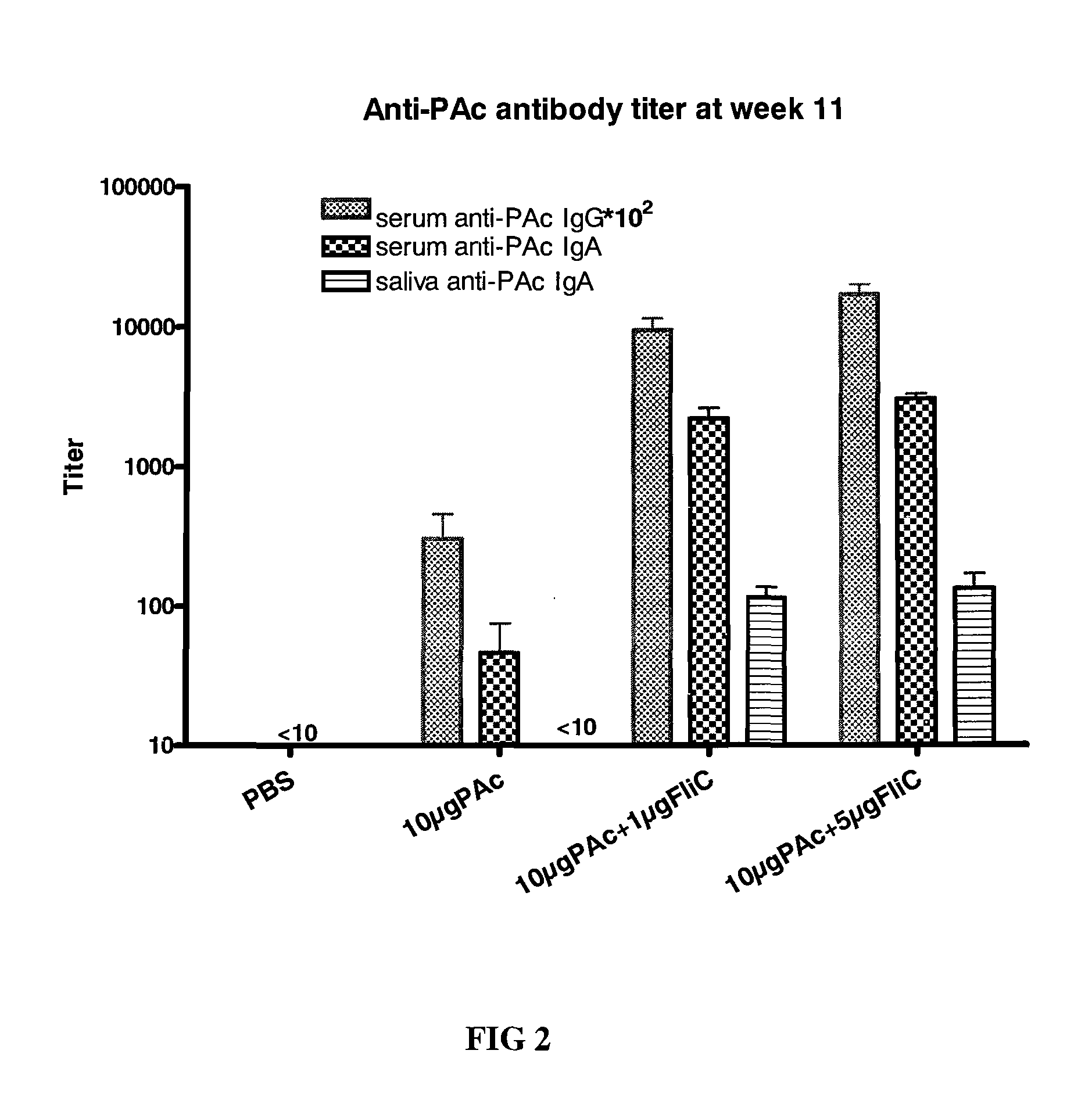Carious tooth vaccine and preparation method
a caries and vaccine technology, applied in the field of vaccines, can solve the problems of high prevalence, high treatment cost, and considerable pain and discomfort of teeth loss
- Summary
- Abstract
- Description
- Claims
- Application Information
AI Technical Summary
Benefits of technology
Problems solved by technology
Method used
Image
Examples
example 1
[0054]S. mutans Ingbritt was grown in brain heart infusion (BHI) broth for 18 h at 37° C. under anaerobic condition, and the cultures were used for infection or stored in glycerol-BHI broth at −70° C. until used.
[0055]Expression and Purification of recombinant PAc and FliC
[0056]pVAX1 is the only vector authorized by the US Food and Drug Adminstration in clinical trials.
[0057]The genes and proteins of PAc and flagellin used are represented by SEQ ID NO 1 (coding sequence of PAc), SEQ ID NO 2(PAc protein), SEQ ID NO 3 (coding sequence of flagellin), and SEQ ID NO 4 (flagelling protein). The fragment of PAc (aa 219-680) encoded by nucleotides (657-2694) and the F1iC were amplified from pertinent bacterial strains and cloned into expression plasmid pET28a using conventional recombinant techniques, resulting in pET28a-PAc or pET28a-FliC respectively. The recombinant PAc and FliC proteins at their C-terminal were fused with a 6HisTag for facilitating purification. Expression plasm...
example 2
Immunization of Mice
[0058]For dose effect, four groups of 8-weeks-old female BALB / c mice (n=5) were intranasally (i.n.) immunized three times at 24-day intervals with (1) PBS, (2) 10 μg PAc, (3) 10 μg PAc+1 μg FliC, or (4) 10 μg PAc+5 μg FliC for each mouse with a volume of 10 μl, where all proteins were dissolved in PBS. Sera and saliva were collected 4 weeks after final immunization. Anesthetized animals were bled, and then sera were obtained from centrifugation of blood samples. Saliva samples were collected after intraperitoneal (i.p.) injection of (50 μl for mice; 250 μl for rats) 200 μg / ml carbachol (Sigma) to stimulate flow. The saliva samples needed to be centrifuged before antibody analysis. Sera and saliva were stored at −70° C. until they were assayed by ELISA.
[0059]For long-lasting effect, three groups of 8-week-old female BALB / c mice (n=5) were intranasally (i.n.) immunized three times at 24-day intervals with (1) PBS, (2) 10 μg PAc, or (3) 10 μg PAc+5 μg FliC for each ...
example 3
Experimental Rat Model
[0061]Six groups of female Wistar rats (n=5) were weaned at 18 days of age and fed with cariogenic diet, Keyes 2000. Antibiotics (ampicillin, chloramphenicol, and carbenicillin, 1.0 g / kg diet or water) were added from days 20 to 22 to temporarily suppress the oral flora to facilitate cariogenic bacterial colonization. From days 24 to 26, the rats were orally challenged with 1×109CFU of S. mutans Ingbritt by the use of swabs presoaked with the bacterial solution. Bacterial samples of the tooth surfaces were examined to verify that each rat was infected.
[0062]The scheme for therapeutic studies was as follows. Days 0-3 were for adaptive feeding; days 4-8 for elimination of oral bacteria by feeding with antibiotics; days 9-14 for planting S. mutans onto teeth; day 14 for prime vaccination; days 39 and 64 for boosting. The scheme for preventive studies was as follows. Days 0-3 were for adaptive feeding; Day 3 for prime vaccination; Days 28 and 52 for boosting; Days ...
PUM
| Property | Measurement | Unit |
|---|---|---|
| size | aaaaa | aaaaa |
| size | aaaaa | aaaaa |
| size | aaaaa | aaaaa |
Abstract
Description
Claims
Application Information
 Login to View More
Login to View More - R&D
- Intellectual Property
- Life Sciences
- Materials
- Tech Scout
- Unparalleled Data Quality
- Higher Quality Content
- 60% Fewer Hallucinations
Browse by: Latest US Patents, China's latest patents, Technical Efficacy Thesaurus, Application Domain, Technology Topic, Popular Technical Reports.
© 2025 PatSnap. All rights reserved.Legal|Privacy policy|Modern Slavery Act Transparency Statement|Sitemap|About US| Contact US: help@patsnap.com



